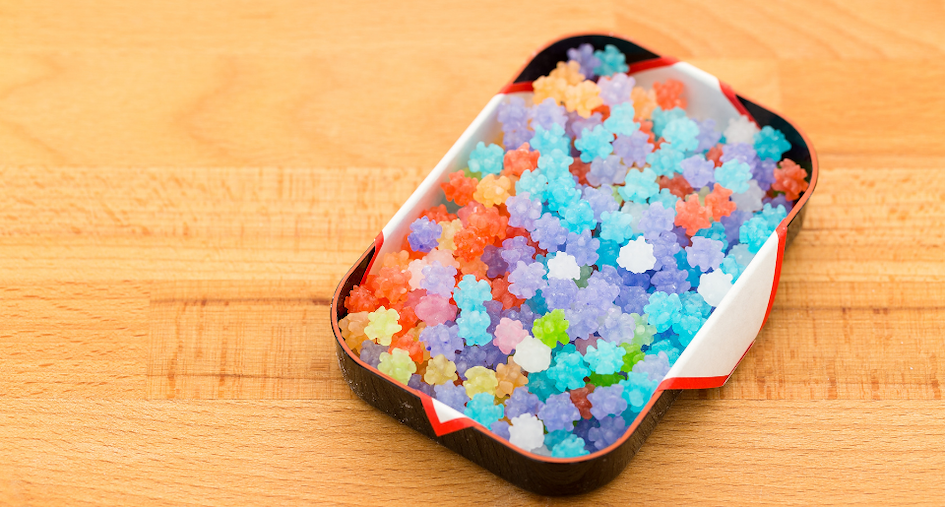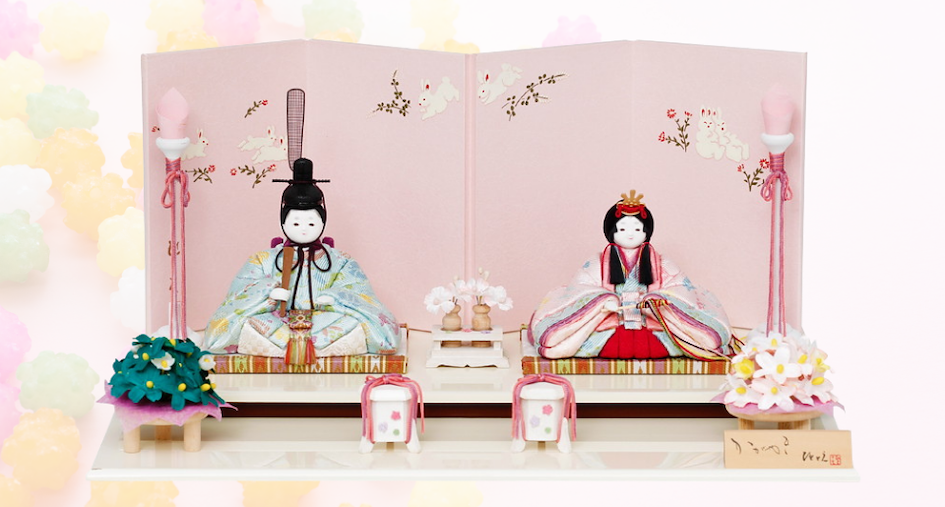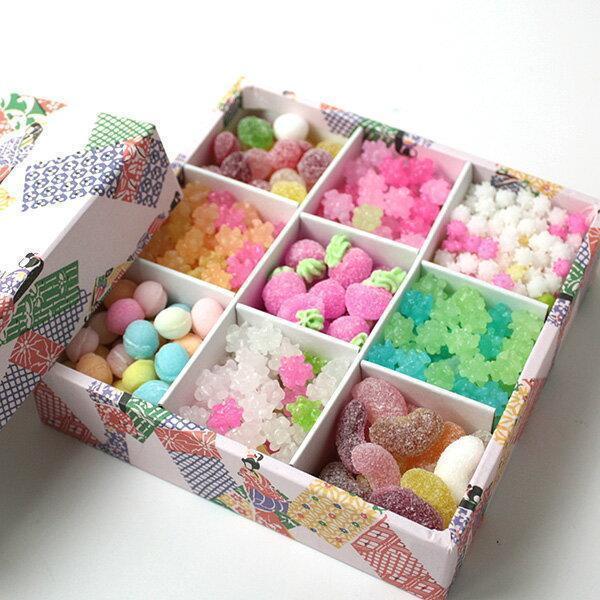The first time you see Konpeito - small, curiously shaped, colorful, and artistically packaged, you might mistake it to be collectible art objects, beads for making jewelry, or traditional Japanese toys. Well, prepare to be pleasantly surprised, as these beautiful, colorful, cute little things are not only a sight to behold but are entirely edible! Talk about literal eye candy!
Konpeito is a traditional small spherical Japanese candy that comes in various colors. This hard sugar candy was introduced to Japan in 1569 by a Portuguese missionary. Today, Konpeito is not only a beautiful sweet candy but also an essential part of Japanese traditions, culture, and history.
In this article, we will be diving into the history of Konpeito as well as how Konpeito affects modern-day Japan. Konpeito is, to this day, a very popular traditional confection. Read on to find out what Konpeito is and where you can learn to make your own!
History of Konpeito.
There seem to be various theories regarding the exact time Konpeito was introduced to Japan, but the most widely accepted time is during 1546. During this time, Konpeito and the technique for making it were introduced to Japan by Portuguese traders and other Western confections such as Castella cake. During this time, sugar was still a rare and luxurious commodity in Japan, only used as Imperial gifts or religious offerings. There is a historical record of a Portuguese Christian missionary called Luís Fróis presenting a glass flask of Konpeito to Oda Nobunaga (one of the most famous and powerful Japanese rulers) as an offering to allow him to carry out his Christian missionary work in Japan.
By the beginning of the Edo Period (1603-1868), sugar became more widely available throughout Japan due to increased trade with the outside world. The making of Konpeito spread first from Nagasaki to Kyoto to Edo(the then capital of Japan). By the Meiji Era (1868 – 1912), Konpeito had permanently etched its place within the Japanese culture as one of the most essential and classic Japanese traditional sweets.
What Does Konpeito Look Like?
Konpeito comes in small round shapes with tiny pointy 'spikes' (don't be scared they are not sharp and won't sting you), making them look like little spherical stars. They come in various colors, such as white, pink, yellow, green, blue, etc. Like many traditional Japanese sweets, the colors are often elegant and subdued, mostly in pastel shades rather than gaudy or overly vivid colors. The rough 'spikes' or 'bumps' on the surface of Konpeito, which result from their particular manufacturing process, give them an adorable and unique appearance. Since they are so small (5 to 10mm in diameter), they are not packaged as single pieces but as packets, boxes, or bags containing one to a few hundred grams of multiple colors of Konpeito.
According to Nakata Tomoichi, researcher of the mathematical aspects of Konpeito and 'Konpeito Fan Club' founder, there are specific characteristics to look for in a Konpeito to distinguish the most high-quality ones.
- An overall shape that is as close as possible to a sphere (not flat or oval)
- The number of 'spikes' or 'bumps' (27 is the ideal number)
- The more translucent, the better (higher opacity means higher concentration of cornstarch)
- Shades of colors that are more 'pastel' than 'neon.'
- Crisp and dense texture rather than light and crumbly texture

What does Konpeito Taste Like?
Although they come in different colors, most Konpeito tastes simple, unflavored sugar. That being said, Konpeito made with unique flavors are also available these days. Some of the flavors these hand-made artisan Konpeito can come in are Yuzu, Matcha, Strawberry, Plum, Orange, Banana, Plain soda, Peach, Pineapple, Vanilla, etc. As Konpeito is considered a type of 'wagashi' traditional Japanese sweet confections, many specialty Wagashi makers craft their versions of Konpeito.
How is Konpeito Made?
Different flavors and unique ingredients can be added to specialty hand-crafted Konpeito using traditional methods at artisanal Japanese confection-making establishments. On the other hand, most industrially manufactured and commonly available Konpeito is made from sugar, water, and edible food coloring.
Although the essential ingredients of Konpeito are straightforward, the making of Konpeito is an art that takes as long as 20 years to fully master! Let's take a look at how Konpeito is made and why it requires so much skill, expertise, and craftsmanship on the connectionists' part to make perfect Konpeito.
- Sugar crystals (rock sugar) and water are heated to a high temperature, turning solid sugar into a dense sugar syrup.
- Something to form the core of the Konpeito is added. Originally this was poppy seeds, but now tiny sugar crystals are used. Everything is heated and continuously rolled around in a tumbler drum called 'gong.' The 'gong' needs to be moved at a specific speed and angle by hand while maintaining the right temperature. At the same time, one has to add and stir the right amount of sugar syrup.
- This continuous rotation at an optimum temperature has to be carried out for a minimum of 10 days. The sugar syrup is layered over and over around the sugar crystal core until it reaches the desired size, density, and hardness. The 'spikes' or 'bumps' on the Konpeito are also formed naturally during this process, but the exact reason behind this is still unknown and is currently undergoing scientific research!
As you can see, it takes at least 10 days to make a batch of Konpeito, and the rotation process can be affected by external factors such as weather conditions. That is why the confectioner has to apply his undivided attention, instinct, expertise, and mastery to make Konpeito. Any minor factor goes wrong during the process, and the whole batch of Konpeito has to be thrown out and started from scratch again.
What is the Cultural Importance of Konpeito in Japan?
As seen in the earlier section, Konpeito has been a historically and culturally significant sweet in Japan since it was introduced in the 16th century. Let's look at some of how it still plays a significant role in Japanese culture.
Konpeito and Japanese Festivals
The colorful and beautiful appearance of Konpeito makes them a perfect food for festivals. There are two major Japanese festivals where Konpeito is displayed and enjoyed as a part of the celebration.
- Hinamatsuri (Girl's Day or Doll's festival) (March 3rd)
This is one of the major Japanese festivals during the spring season. This day in Japan celebrates everything girly, colorful, and beautiful. Konpeito is displayed along with dolls and enjoyed as a dessert item and other colorful dishes.

Tanabata is one of the biggest summer festivals in Japan celebrated on various days during July or August. It is based on a legend of two star-crossed lovers who can meet only once a year, on a specific day. Everything about this festival is colorful, dreamy, and astronomy and astrology-based. So it is no wonder that Konpeito, with its colorful star-like shapes, has been an indispensable part of the Tanabata festival since the Edo period.
Konpeito and Japanese Tea Ceremony.
The traditional Japanese tea ceremony is one of the three primary Japanese refined art forms, and it embodies the traditional art of preparing and serving Matcha (Japanese powdered green tea). As an accompaniment to bitter Matcha tea, traditional Japanese sweets called Wagashi are served, and Konpeito is one of them. The sweetness of the Konpeito balances out the Matcha's intense bitterness perfectly.
Konpeito as a Ceremonial Gift.
Konpeito has been used as a luxurious gift or offering for ceremonial events for centuries in Japan. In Japan, there is a long-living tradition called 'Hikidemono,' when one offers a gift (often quite expensive and of premium quality) from the guests to the invitees at ceremonial events such as weddings and childbirth, graduation, etc. One of the most common "Hikidemono" is 'Bonbonniere,' like an assorted candy and sweet treats box. Konpeito is one of the common items included in this "Bonbonniere" box. Konpeito is also offered at religious events at temples and shrines.

Konpeito as an Emergency Ration.
Since Konpeito is essentially sugar, it can stay fresh even as long as 20 to 30 years if kept in a cool and dry condition. On top of that, it is a good source of calories in situations where food might be scarce. These qualities make Konpeito an excellent item to be included in emergency ration food stocks. In Japan, Konpeito is an official item included in the Ministry of Defense's Emergency Food Ration tin and in the Imperial Army's Military Combat Ration tins. The colorful visuals of Konpeito and the positive and nostalgic sentiment attached to them are believed to raise morale and provide hope during times of difficulties and disaster.
Konpeito in Popular culture.
Konpeito's colorful and cute appearance seems to make it a very popular sweet to be depicted in artistic and imaginative creations. It has been featured in some of the most famous Japanese anime, games, and movies such as Pokemon, Sailor Moon, Bleach, Super Mario, Spirited Away, etc.
Konpeito is also the main theme of one of the oldest Japanese counting songs for children. The use of Konpeito shaped beads in the making of jewelry is also common in Japan.
Where to Buy Konpeito.
Mass-produced Konpeito made by large manufacturers is readily available anywhere in Japan. They can usually be found at the candy or snack sections of convenience stores, supermarkets, Dagashiya (traditional Japanese sweets and snack shops), major train stations, as well as at various gift or souvenir shops.
If you are looking for specialty Konpeito, it is a different story. Although Japan does have specialty Konpeito makers, they are pretty rare today. These artisan Konpeito-makers are usually family businesses passed down multiple generations. Since the skills to hand-craft Konpeito take years to master, the younger generations are not as eager as in the old times to take on the responsibilities of being a Konpeito confectioner. Below are two of Japan's most famous and renowned artisan Konpeito makers.
Established in 1847, Ryokujuan Shimizu is the most famous Konpeito specialty shop in Japan, solely dedicated to the art of Konpeito. It is also located in Kyoto, the center of traditional Japanese confection. Ryokujuan Shimizu is unique in the fact that it offers innovative flavors and tastes in their Konpeito while at the same time paying due respect to the tradition and history of Konpeito. Long queues of eager customers in front of the shop is a regular sight when it comes to this shop.
They offer season-specific flavors such as pumpkin flavor in December and cherry, cherry blossoms, and peach flavors during the spring months. Unique flavors such as plum-liqueur, brandy, Vone Romanevan Rouge, Sake, etc., are also available. They also sell local hand-crafted containers (Kiyomizu ware pottery) that can be bought separately to put your precious Konpeito in.
Uji-en is a renowned Japanese specialty tea and Wagashi shop with various store locations across Japan. Their Konpeito comes in multiple flavors: lemon, soda, wine, cherry blossoms, etc. Each assortment is packaged in Uji-en's signature cases with a spherical shape with a retro-style artistic design. Uji-en's Konpeito is a trendy gift item in Japan, and even the younger generation exchange them as Valentine's Day presents.
Where To Learn More About Konpeito: Konpeito Museum
Where to learn more about Konpeito – Konpeito Museum.
Still hungry for more Konpeito knowledge and want to have a first-hand experience of Konpeito-making? Well, there is a perfect place to do that - Japan's Konpeito museum. There are three locations for this fantastic museum – two in Osaka (Yao and Sakai) and one in Fukuoka. The main attractions of Konpeito museum are:
There are presentations, theatrical storytelling, and movies that you can enjoy at the museum to learn everything about Konpeito in detail, including their history, how they are made, the science behind the Konpeito-making process, etc.
- First-hand experience of Konpeito-making:
You can make your 'My Konpeito' at this museum which means you get to decide the color and flavors to create your unique Konpeito with the help of Konpeito experts who will guide and help you through the entire process. How exciting!
The museum has its shop (also available online) where many cute Konpeito-themed goods and souvenirs are sold. At the store, you can sample and buy Konpeito with rare and exciting flavors that are difficult to find elsewhere, such as salt, wine, chocolate, coffee, and mushroom!
Read More: WHAT ARE TRADITIONAL JAPANESE CONFECTIONS